Related Research Articles

William Wilkie Collins was an English novelist and playwright known especially for The Woman in White (1859), a mystery novel and early sensation novel, and for The Moonstone (1868), which established many of the ground rules of the modern detective novel and is also perhaps the earliest clear example of the police procedural genre.

Robert William Chambers was an American artist and fiction writer, best known for his book of short stories titled The King in Yellow, published in 1895.

Sir Anthony Hope Hawkins, better known as Anthony Hope, was a British novelist and playwright. He was a prolific writer, especially of adventure novels but he is remembered predominantly for only two books: The Prisoner of Zenda (1894) and its sequel Rupert of Hentzau (1898). These works, "minor classics" of English literature, are set in the contemporaneous fictional country of Ruritania and spawned the genre known as Ruritanian romance, books set in fictional European locales similar to the novels. Zenda has inspired many adaptations, most notably the 1937 Hollywood movie of the same name and the 1952 version.
This article contains information about the literary events and publications of 1895.

George Meredith was an English novelist and poet of the Victorian era. At first, his focus was poetry, influenced by John Keats among others, but Meredith gradually established a reputation as a novelist. The Ordeal of Richard Feverel (1859) briefly scandalised Victorian literary circles. Of his later novels, the most enduring is The Egoist (1879), though in his lifetime his greatest success was Diana of the Crossways (1885). His novels were innovative in their attention to characters' psychology, and also portrayed social change. His style, in both poetry and prose, was noted for its syntactic complexity; Oscar Wilde likened it to "chaos illumined by brilliant flashes of lightning". Meredith was an encourager of other novelists, as well as an influence on them; among those to benefit were Robert Louis Stevenson and George Gissing. Meredith was nominated for the Nobel Prize in Literature seven times.
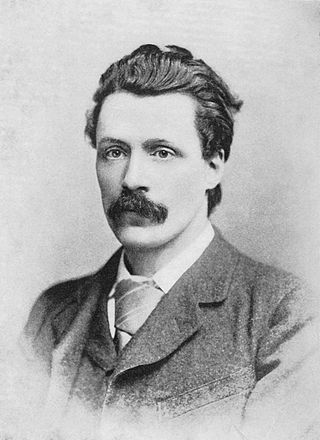
George Robert Gissing was an English novelist, who published 23 novels between 1880 and 1903. In the 1890s he was considered one of the three greatest novelists in England, and by the 1940s he had been recognised as a literary genius. Gissing's best-known works have reappeared in modern editions. They include The Nether World (1889), New Grub Street (1891) and The Odd Women (1893). He retains a small but devoted group of followers.

Sir Walter Besant was an English novelist and historian. William Henry Besant was his brother, and another brother, Frank, was the husband of Annie Besant.
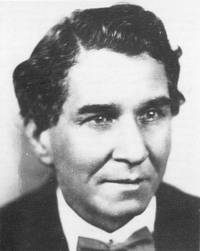
Matthew Phipps Shiell, known as M. P. Shiel, was a British writer, remembered mainly for supernatural horror and scientific romances. His work was published as serials, novels, and as short stories. The Purple Cloud remains his most often reprinted novel.

Archibald Gordon Macdonell was a Scottish writer, journalist and broadcaster, whose most famous work is the gently satirical novel England, Their England (1933).

George William MacArthur Reynolds was a British fiction writer and journalist.
Philip MacDonald was a British-born writer of fiction and screenplays, best known for thrillers.

Morley Charles Roberts was an English novelist and short story writer, best known for The Private Life of Henry Maitland.

In literature, a serial is a printing or publishing format by which a single larger work, often a work of narrative fiction, is published in smaller, sequential instalments. The instalments are also known as numbers, parts, fascicules or fascicles, and may be released either as separate publications or within sequential issues of a periodical publication, such as a magazine or newspaper.

The Nether World is a novel written in 1889 by the English author George Gissing. The plot concerns several poor families living in the slums of 19th-century London. Rich in naturalistic detail, the novel concentrates on the individual problems and hardships which result from the typical shortages experienced by the lower classes—want of money, employment and decent living conditions. The Nether World is pessimistic and concerns exclusively the lives of poor people: there is no juxtaposition with the world of the rich.

Richard Bentley was a 19th-century English publisher born into a publishing family. He started a firm with his brother in 1819. Ten years later, he went into partnership with the publisher Henry Colburn. Although the business was often successful, publishing the famous "Standard Novels" series, they ended their partnership in acrimony three years later. Bentley continued alone profitably in the 1830s and early 1840s, establishing the well-known periodical Bentley's Miscellany. However, the periodical went into decline after its editor, Charles Dickens, left. Bentley's business started to falter after 1843 and he sold many of his copyrights. Only 15 years later did it begin to recover.

Rachel Ray is an 1863 novel by Anthony Trollope. It recounts the story of a young woman who is forced to give up her fiancé because of baseless suspicions directed toward him by the members of her community, including her sister and the pastors of the two churches attended by her sister and mother.
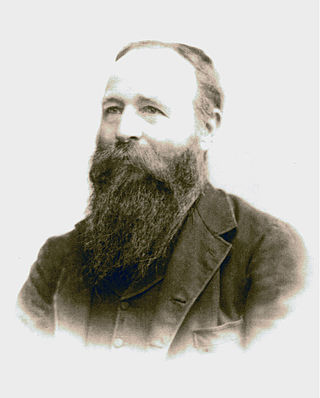
Frank Atha Westbury, who wrote under the pen names of "Atha" and "Atha Westbury", was a popular and prolific author of mystery adventure novels, children's stories and poetry in late 19th century Australia and New Zealand. Most of his fiction was serialised in newspapers and journals between 1879 and 1905. His two major works were: The Shadow of Hilton Fernbrook, A Romance of Maoriland (1896) and Australian Fairy Tales (1897), which won him a place as one of the better-known writers for children in Victorian-era Australia. Many of his novels were adventure romances set in New Zealand at the time of the New Zealand Wars of the 1860s, which the author experienced as a soldier in the British Army.
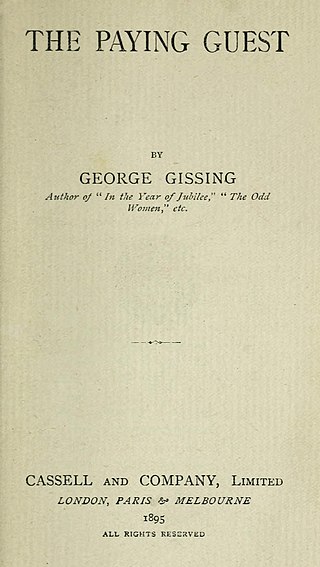
The Paying Guest is a satirical novella by George Gissing, first published in 1895 by Cassell, as part of their Pocket Library series. It recounts the experiences of the Mumfords, a middle-class family who invite a "paying guest" into their home to supplement their income. Written in an unusually comic tone compared with Gissing's earlier works, The Paying Guest was generally received well by critics. Gissing himself, however, was not satisfied with the work.
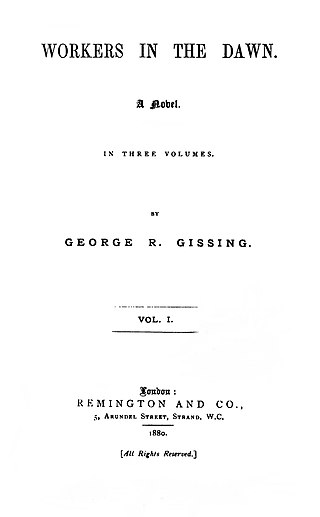
Workers in the Dawn is a novel by George Gissing, which was originally published in three volumes in 1880. It was the first of Gissing's published novels, although he had been working on another prior to this. The work focuses on the unhappy marriage of Arthur Golding, a rising artist from a poor background, and Carrie Mitchell, a prostitute. This plot was partly based on Gissing's negative experiences of marriage to his first wife. It also was designed to serve the function of political polemic, highlighting social issues that Gissing felt strongly about. Reviews of the novel generally recognised some potential in the author, but were critical of Workers in the Dawn. After reading the first known published review in the Athenaeum, Gissing was driven to describe critics as "unprincipled vagabonds".

David Christie Murray was an English journalist, who also wrote fiction.
References
- ↑ Law, Graham (2007). ""A Vile Way of Publishing": Gissing and Serials". Victorian Review . 33 (1): 82. doi:10.1353/vcr.2007.0052. JSTOR 27793626. S2CID 165429056.
- 1 2 Jacob Korg (1975). George Gissing: A Critical Biography. Taylor & Francis. pp. 198–199. Retrieved 3 May 2012.
- ↑ "Yesterday's new books". Evening Standard . London. 5 April 1895.
- ↑ Barbara Rawlinson (2006). A Man of Many Parts: Gissing's Short Stories, Essays and Other Works. Rodopi. pp. 181–182. ISBN 978-90-420-2085-6 . Retrieved 6 May 2012.
- ↑ Philmus, Robert M. (July 1977). "H.G. Wells as Literary Critic for the Saturday Review". Science Fiction Studies . 4 (2): 177. JSTOR 4239112.
- ↑ "Recent novels". The Morning Post . 24 May 1895.
- 1 2 Pierre Coustillas (1996). George Gissing: The Critical Heritage. Psychology Press. pp. 248–254. ISBN 978-0-415-13468-2 . Retrieved 3 May 2012.